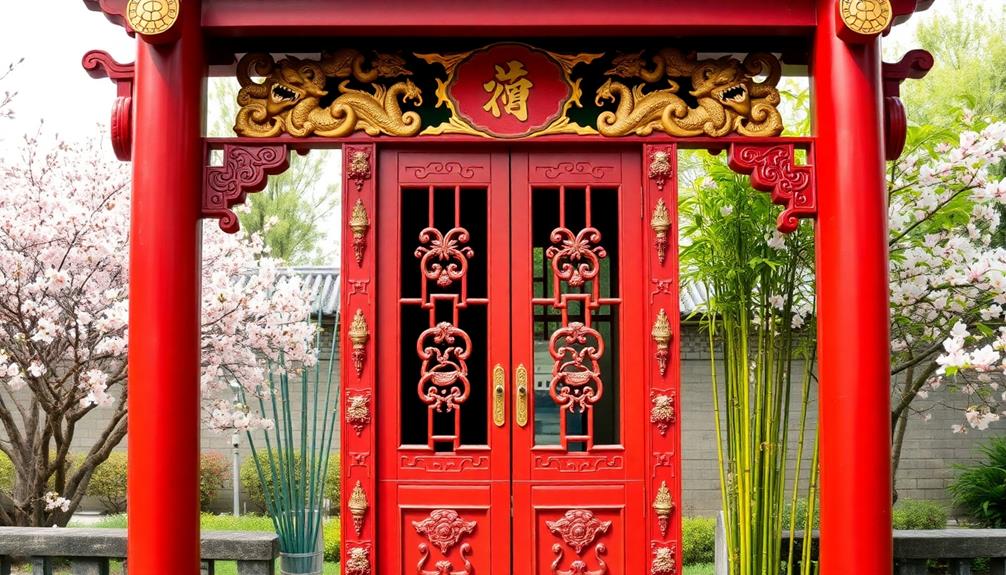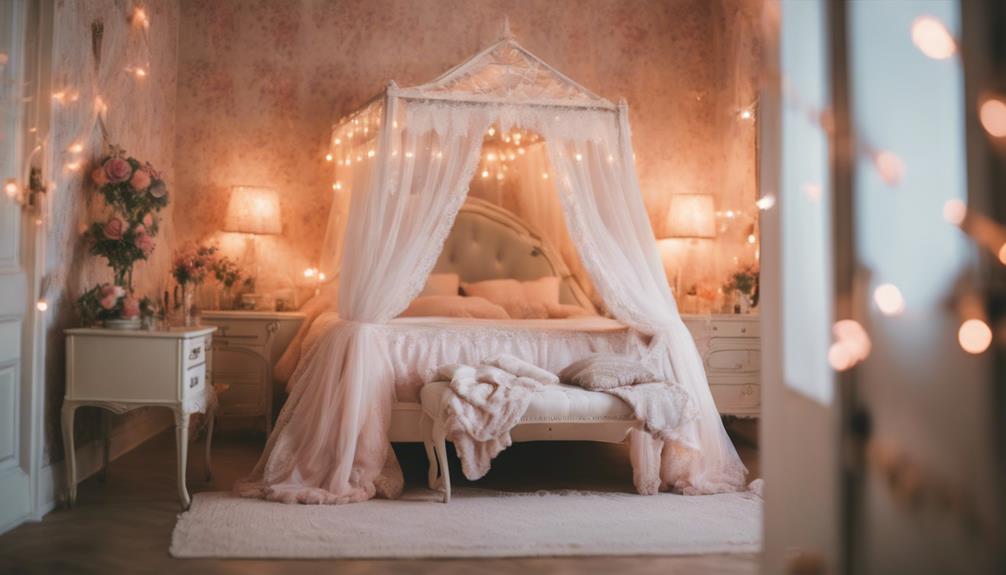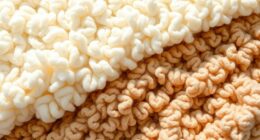Revealing the meaning of Chinese door symbols reveals a rich tapestry of cultural significance. These symbols, like the Fu symbol for good fortune and the Double Happiness sign for marital bliss, do more than decorate doors; they invite positive energy and embody hopes and traditions. Feng shui principles guide their placement, enhancing the flow of qi in your space. Whether you admire traditional intricate designs or modern interpretations, each symbol reflects deep-rooted beliefs and societal values. You'll discover the fascinating variations by region and the practical implications for design that can elevate your space even further.
Key Takeaways
- Chinese door symbols, like the Fu and Double Happiness, embody cultural beliefs related to protection, good fortune, and harmonious relationships.
- The Fu symbol invites positive energy and prosperity, while the Double Happiness symbol reflects aspirations for marital bliss.
- The Dragon and Phoenix symbols represent power, protection, rebirth, and good luck, showcasing significant cultural roots.
- Feng shui principles guide the placement of symbols to enhance energy flow and intentions in living spaces.
- Traditional designs are intricate and culturally significant, while modern interpretations offer fresh aesthetics while maintaining cultural relevance.
Historical Roots of Door Symbols
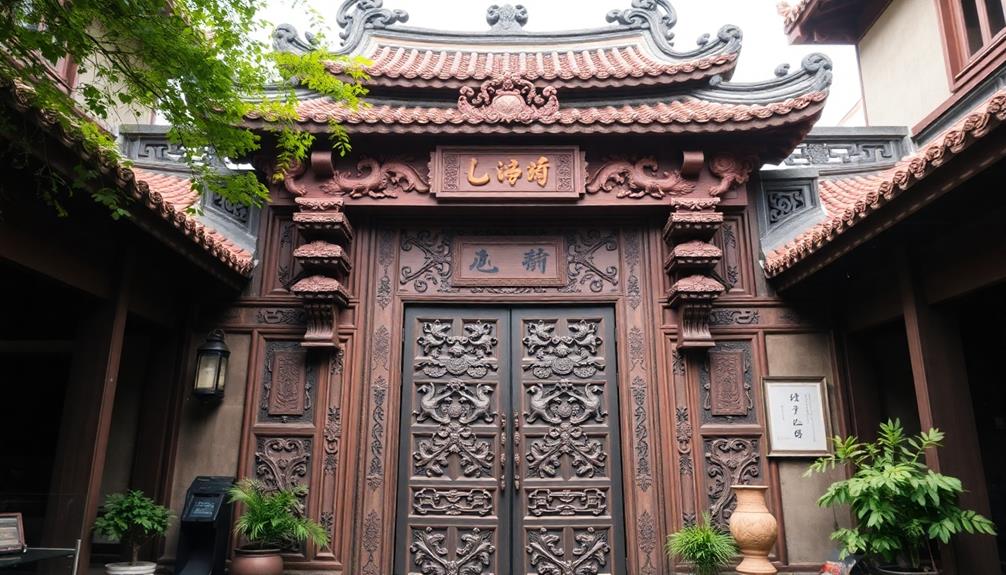
Throughout history, countless cultures have used symbols to convey meaning, and Chinese door symbols are no exception. These symbols date back thousands of years, rooted in a rich tapestry of cultural beliefs and historical events.
You'll find that they often serve purposes like protection and attracting good fortune, reflecting the values and aspirations of society. The intricate designs showcase remarkable craftsmanship while indicating social status and artistic expression.
As you explore these symbols, you'll see how they evolved alongside societal norms, adapting to reflect changing beliefs and cross-cultural influences. Understanding their historical context helps you appreciate their significance and the deep-rooted traditions they embody, making them more than mere decorations on doorways.
Popular Chinese Door Symbols
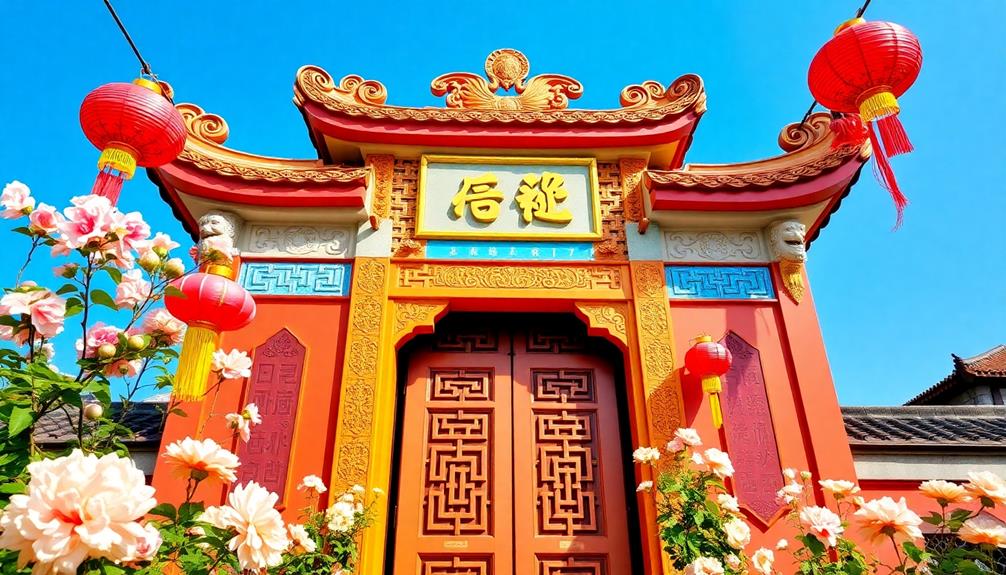
Understanding the historical roots of Chinese door symbols sets the stage for exploring their popular manifestations today.
You'll find that iconic symbols like the Fu Symbol, representing good fortune, or the Double Happiness Symbol, signifying marital bliss, are commonly displayed.
The Dragon Symbol embodies power and protection, while the Phoenix Symbol symbolizes rebirth and good luck.
Each of these symbols invites positive energy and wards off negativity, making them integral to many households.
For instance, during Chinese New Year, you might see the Fu Symbol displayed upside down, indicating luck's arrival.
Symbolic Meanings and Interpretations
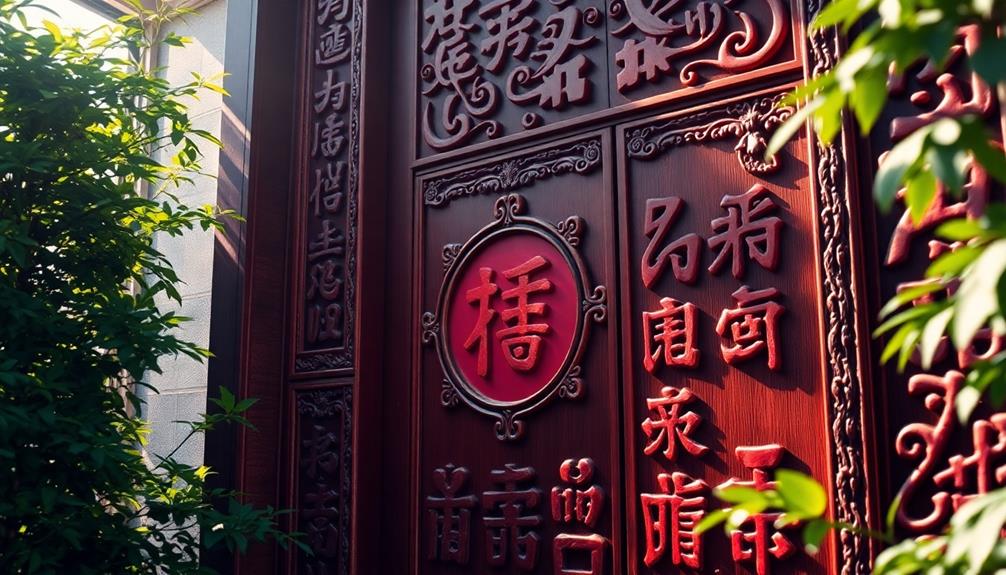
Chinese door symbols carry rich symbolic meanings that resonate deeply within cultural contexts. Each symbol, like the Fu Symbol for good fortune or the Double Happiness Symbol for marital bliss, invites positive energy and reflects aspirations for prosperity.
You'll find that the Dragon Symbol represents power and protection, while the Phoenix Symbol signifies rebirth and good luck.
These symbols aren't just decorative; they connect you to historical beliefs, embodying values that have transcended generations. By understanding their meanings, you can enhance your appreciation of these beautiful designs and their role in your home.
They serve not only as cultural touchstones but also as expressions of hope and harmony, enriching your living space with their significance.
Feng Shui and Energy Flow

Feng shui principles play an essential role in the effective placement and selection of door symbols, as they focus on the flow of energy, or qi, within your living space.
To enhance positive energy, carefully choose symbols that resonate with your intentions. For instance, place the Fu Symbol above your entrance to invite good fortune or the Double Happiness Symbol to promote harmony in relationships.
Pay attention to the direction and height of these symbols; ideally, they should be at eye level and face the main thoroughfare.
Traditional vs. Modern Designs
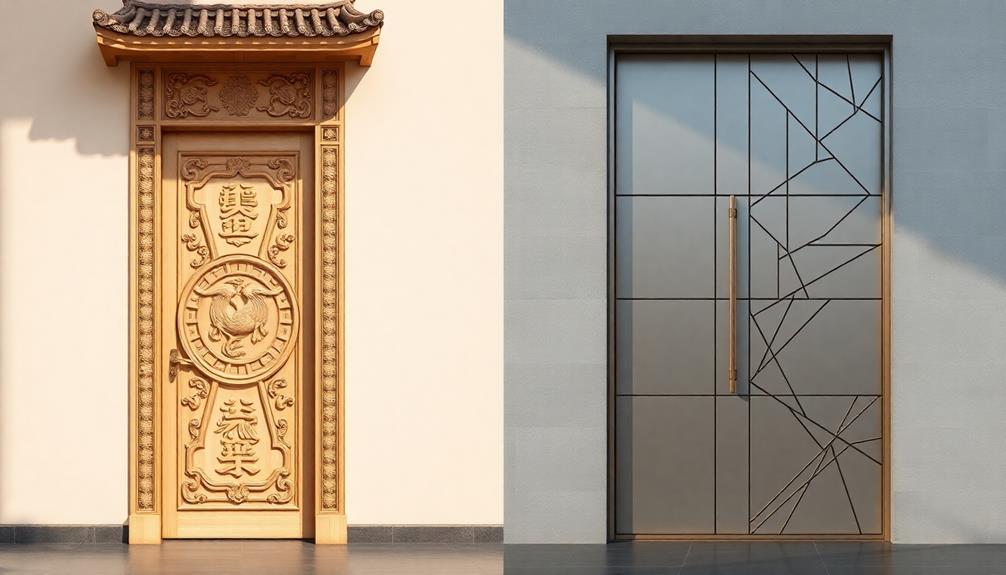
Door symbols have evolved considerably over time, blending traditional elements with modern aesthetics.
In traditional designs, you'll find intricate patterns and vibrant colors influenced by Confucianism, Taoism, and Buddhism, each symbol carrying deep cultural significance. These designs often invoke positive energies and reflect historical beliefs.
However, modern interpretations bring a fresh twist. You can see contemporary motifs and multicultural influences, allowing you to personalize the symbols according to your taste and lifestyle.
This fusion maintains the cultural relevance of the symbols while making them accessible and appealing in today's context.
Regional Variations and Contexts
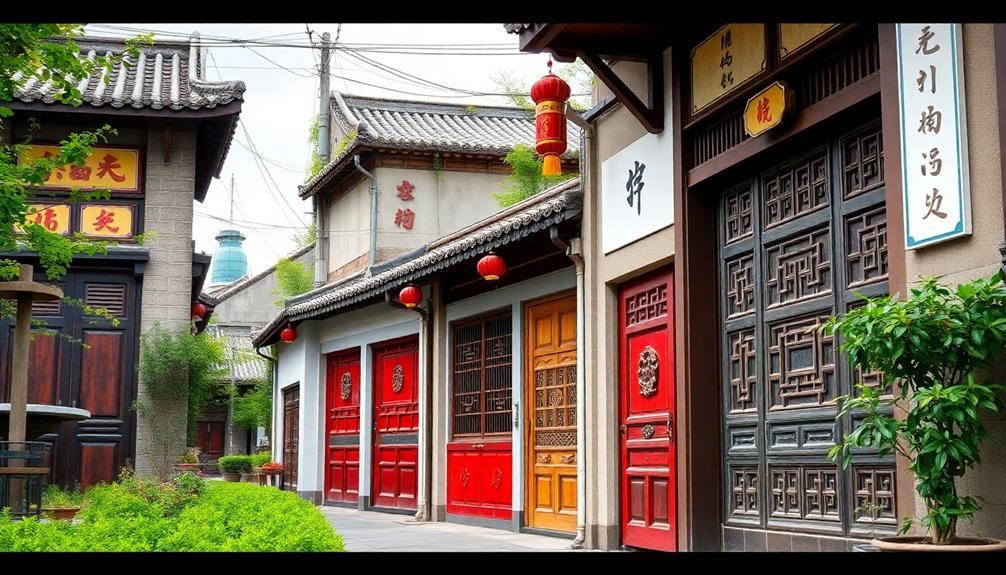
Across different regions, door symbols showcase unique variations that reflect local cultures and histories. For instance, in northern China, you might find intricate carvings of dragons and phoenixes, representing power and rebirth.
Meanwhile, southern regions often favor the Fu symbol, celebrating good fortune with vibrant colors and patterns.
Consider these striking differences:
- Dragons spiraling around door frames, exuding strength and protection.
- Colorful paper cuttings of the Double Happiness symbol, enhancing marital bliss.
- Wooden plaques adorned with auspicious phrases, connecting tradition to modern life.
- Bold red banners proclaiming prosperity during the Lunar New Year, inviting joy into homes.
These variations not only enrich cultural identity but also remind you of the deep-rooted traditions within each community.
Practical Applications in Design
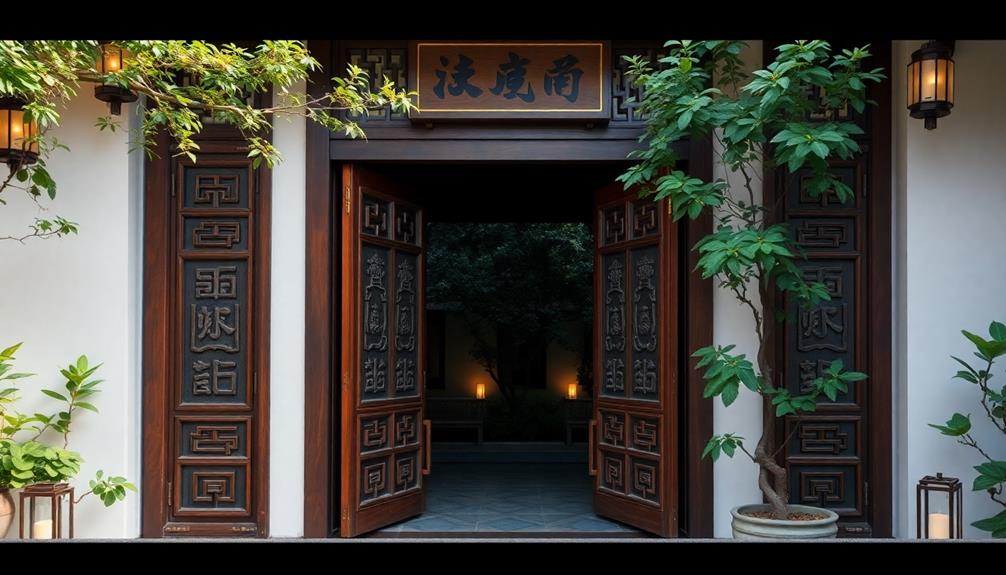
Incorporating Chinese door symbols into your design can elevate both aesthetics and cultural significance in your space. You can use these symbols in various ways, from wall art to decorative elements. Here's a quick guide to help you choose:
| Symbol | Meaning |
|---|---|
| Fu Symbol | Good fortune and happiness |
| Double Happiness | Marital bliss |
| Dragon Symbol | Power and protection |
| Phoenix Symbol | Rebirth and good luck |
| Golden Toad | Wealth and prosperity |
Frequently Asked Questions
What Materials Are Commonly Used for Crafting Chinese Door Symbols?
When crafting Chinese door symbols, artisans typically use materials like wood, metal, and paper. Each material offers unique textures and finishes, enhancing the symbols' aesthetic appeal while representing cultural significance in your home decor.
Are There Specific Rituals Associated With Placing Door Symbols?
Did you know 90% of households in China use door symbols? When placing them, you should follow rituals like cleansing the area and reciting blessings, ensuring they attract positive energy and good fortune into your home. These symbols, often featuring auspicious characters or images, are believed to create a harmonious environment and ward off negativity. Proper placement is key, as it aligns with traditional practices and enhances their effectiveness. Just like observing these customs, addressing practical household concerns, such as when you solve garage door yellow light issue, helps maintain a balanced and well-functioning home.
Can Door Symbols Be Used in Non-Chinese Cultures?
Yes, you can definitely use door symbols in non-Chinese cultures. They often represent universal themes like protection and good fortune, allowing you to blend cultural elements and enhance the aesthetic and spiritual atmosphere of your space.
How Do Door Symbols Differ in Urban Versus Rural Settings?
In urban settings, door symbols often reflect contemporary designs and multicultural influences, while rural areas embrace traditional motifs emphasizing heritage. You'll notice differing aesthetics and meanings based on cultural context and lifestyle variations in these environments.
Are There Any Superstitions Related to Chinese Door Symbols?
You might think superstitions are silly, but many believe Chinese door symbols bring luck and protection. By placing them strategically, you invite positive energy and ward off negativity, enhancing your home's harmony and spirit.
Conclusion
As you close this chapter on Chinese door symbols, remember that each design is a key to revealing deeper cultural connections and personal aspirations. Like a well-tended garden, these symbols flourish, inviting prosperity and protection into your life. Whether you choose to adorn your home with the Fu or the Double Happiness, you're not just decorating; you're weaving a rich tapestry of tradition and energy. Embrace these symbols, and let them guide you toward a vibrant, harmonious existence.
